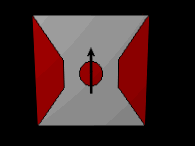
Materials Research Science and Engineering Center: Faculty Publications
Document Type
Article
Date of this Version
5-15-2005
Abstract
Measured positive values of the spin polarization of the tunneling current from 3d ferromagnetic metals are commonly explained by the dominant s-electron contribution based on symmetry considerations for bulk materials, ignoring the influence of the interfaces. In this work, three different models are considered which suggest that the spin polarization is primarily determined by the electronic and atomic structures of the ferromagnet/insulator interfaces rather than by the bulk properties. A simple tight-binding model demonstrates that the existence of interface states and their contribution to the tunneling current depend on the degree of hybridization between the orbitals on metal and insulator atoms. The decisive role of the interface bonding is further supported by considering spin-dependent tunneling from oxidized Co surfaces through vacuum and in Co/Al2O3/Co tunnel junctions within the first-principles Green's-function approach. For the oxidized Co surface it is found that the Co–O bonding at the surface removes the conducting orbitals forming the bulk Bloch states from the Fermi level, creating an additional tunneling barrier for minority-spin electrons. For the Co/Al2O3/Co junctions, two types of the interface O atoms are distinguished: those which saturate Al bonds and those which are adsorbed by Co. The latter bind strongly to Co creating interface states which enhance the tunneling current in the majority-spin channel. In both cases, the spin polarization changes sign and becomes positive, evidencing the crucial role of the interface structure and bonding.


Comments
Published by American Institute of Physics. J. Applied Physics 97, 10C910 (2005). ©2005 American Institute of Physics. Permission to use. http://jap.aip.org/jap/.